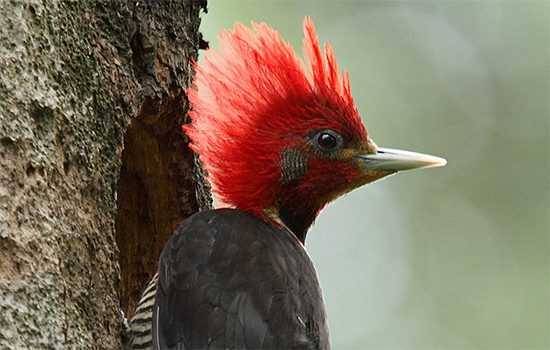A First for the Atlantic Forest: Radio-Tracking the Helmeted Woodpecker
By Martjan Lammertink February 25, 2014

Attracted by the possibility to study a little-known, endangered woodpecker in a region in need of forest conservation, I moved to Misiones province in northeast Argentina in 2011. My aim was to study the requirements of the Helmeted Woodpecker in old-growth and logged forests. I also wanted to learn how it coexists and possibly competes ecologically with two similar large woodpeckers, the Lineated Woodpecker (Dryocopus lineatus) and Robust Woodpecker (Campephilus robustus), which both can cope with a higher degree of forest disturbance than the Helmeted Woodpecker can.
It proved to be a hard species to study. Whereas most woodpeckers noisily call and drum at the beginning of their breeding seasons if not year-round, the Helmeted Woodpecker is a silent bird. This makes it difficult to find and study in its dense subtropical forest environment. It typically gives only a handful of calls, right around sunrise, for a few days in winter and early spring. It rarely drums, its foraging hammering is soft, and it ranges over rather large areas.

It was clear from the start that we would have to use radio-telemetry to study this species—something that had never been done before. My field assistant, a park-ranger student named Carlos Ferreyra, and I spent 2012 trying to catch the birds so that we could attach radio-transmitters, and cutting extensive trail networks so that we’d be able to follow them. But it wasn’t until 2013 that we caught our first one.
In July 2013, in the heart of the austral winter, we were rotating among six banding sites at small clearings in the forest. In the pre-dawn dark, we would open fine, almost invisible mist nets and place a woodpecker decoy with a sound amplifier between them. We played Helmeted Woodpecker calls from a blind at first light. Over the next month, on some days no woodpeckers responded; other days they would call back and fly over the trapping site. But they still wouldn’t come down to the mist nets.
We made our twelfth trapping attempt of the year on August 8. At first no woodpeckers responded to the playback. Then suddenly a Helmeted Woodpecker swooped silently over and landed nearby. Another brief fragment of playback lured the bird down and into the net! It was a beautiful male, with a long crest and red malar stripe. We quickly weighed and color-banded the bird, attached a tail-mounted radio-transmitter, and freed him just 14 minutes later. The transmitter weighed about 3 grams (just over one-tenth of an ounce), and we glued it to the base of the central tail feathers, where it wouldn’t interfere with the bird’s movements. It would stay on until the next time the bird molted, in fall. We also banded the bird with a unique combination of color bands so we can recognize it in the following years.

During the next three months we followed the bird around, slogging through dense bamboo and up and down steep slopes. For the first time, we were able to map a Helmeted Woodpecker’s home range and make detailed observations about its foraging ecology.
A month after we captured the male, we caught and radio-tagged a female Helmeted Woodpecker near her roost cavity, using an aerial mist net mounted 45 feet up in the trees. Setting up that net took 10 days, shooting lines over branches with a catapult and bending branches and small trees out of the flight path toward the net. On two separate mornings the woodpecker flew into the net but escaped; finally on the third try we caught her. We were even more thrilled to discover that, although the roost of this female and that of the radio-tagged male were three-quarters of a mile apart, the two were a pair. To our excitement, they soon began excavating a nest cavity, and for the first time we were able to follow the complete breeding cycle of a Helmeted Woodpecker pair. On November 5, a single young fledged from their nest.

This past November and December, we also radio-tagged and followed a pair of Lineated Woodpeckers, which we found to have a much smaller home range than the Helmeted Woodpeckers and with more overlap between the ranges of the male and female.
In 2014, we will be working with a larger field team of researchers and students, and we expect to follow more radio-tagged woodpeckers. We hope to learn about their home range placement and their selection of foraging, roosting, and nesting trees by following multiple woodpecker individuals of each species. The ultimate goal of our project is to provide recommendations on how to design protected areas and restore the ecological integrity of logged forests. The outlook is good that our work will result in improved conservation of Atlantic Forest biodiversity, as we are working with the Ministry of Ecology of Misiones Province, the local organization Proyecto Selva de Pino Paraná, and the forestry company Alto Paraná.
- More about Martjan Lammertink: read about his search with Tim Gallagher for the Imperial Woodpecker of Mexico.
(Photos by Martjan Lammertink.)

All About Birds
is a free resource
Available for everyone,
funded by donors like you
American Kestrel by Blair Dudeck / Macaulay Library
